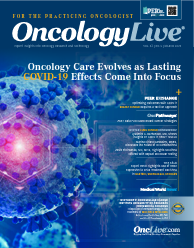Publication
Article
Oncology Care Evolves as Lasting COVID-19 Effects Come Into Focus
Author(s):
The pandemic appears to have caused or contributed to a number of lasting changes in the way oncologists provide clinical care to their patients.
David R. Penberthy, MD, MBA

The pandemic appears to have caused or contributed to a number of lasting changes in the way oncologists provide clinical care to their patients. But clinicians note that as the nature of the health crisis continues to evolve any shifts in treatment patterns or methods instituted to lower the risk of COVID-19 infection must be supported with data showing they provide the best possible outcomes.
Two years into the COVID-19 pandemic, early efforts to combat early surges of infection have resulted in the relatively quick adoption of new standard practices. For example, telemedicine has been embraced by clinicians and patients as a way to avoid in-person visits and reduce the risk of exposure with wide use likely to remain in effect for safety and convenience. Hypofractionated radiotherapy, which requires fewer trips to the clinic, has accelerated, both at academic centers and community practices. Changes such as prescribing oral drugs rather than having patients come in for infusions, using neoadjuvant therapy to delay surgery, and moving to less frequent immunotherapy doses, have spread and are poised to become more common in the future, oncologists say.
"Oncology has this long history of clinical trials, of standing on the shoulders of giants, of development of the appropriate care for the appropriate situation,” David R. Penberthy, MD, MBA, said in an interview with OncologyLive®. “We still use the most up-to-date, evidence-based guidelines for treatment,” added Penberthy, who is the medical director for radiation oncology at Bon Secours — Southside Regional Medical Center in Petersburg, Virginia, and incoming president of the Association of Community Cancer Centers.
Although vaccinations and safety protocols have largely allowed patients and oncologists to safely resume in-person visits and dial back many early practice adaptations, some offices and clinics are now struggling with burnout and staff shortages, especially during the recent omicron surge. “Treatments are dependent on the clinical situation and the most appropriate care for that clinical situation,” Penberthy said.
Telehealth Leaves its Mark
Health providers of all types quickly adopted telemedicine or virtual health care after the pandemic began in March 2020. Results of an analysis of 16,006 newly diagnosed patients with cancer in an insurance claims database found their rate of telemedicine visits increased from 0.4% in January 2020 to a peak of 54% in April 2020, before declining to a little over 20% by that August.1 In a study of 3473 physicians in Boston-area hospitals, more than 94% of providers transitioned to include virtual health care in their practice by December 2020.2
FIGURE 1. Snapshot of the COVID-19 Pandemic on Oncology Care
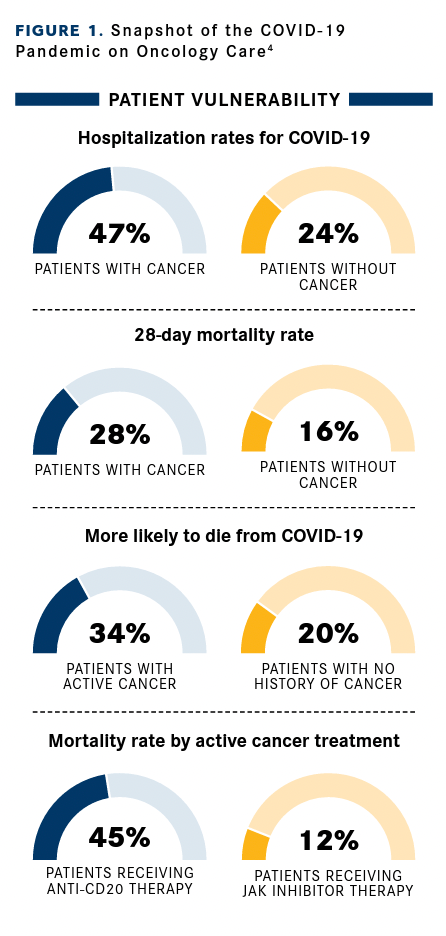
“I absolutely think telemedicine is here to stay. It’s going to [continue to] be a very effective option,” Penberthy said. “Some of my colleagues are spending 1 afternoon per week doing all telemedicine [visits], and they can be as productive as they are in the clinic.”
FIGURE 2. Clinical Trial Changes Permitted During the COVID-19 Pandemic
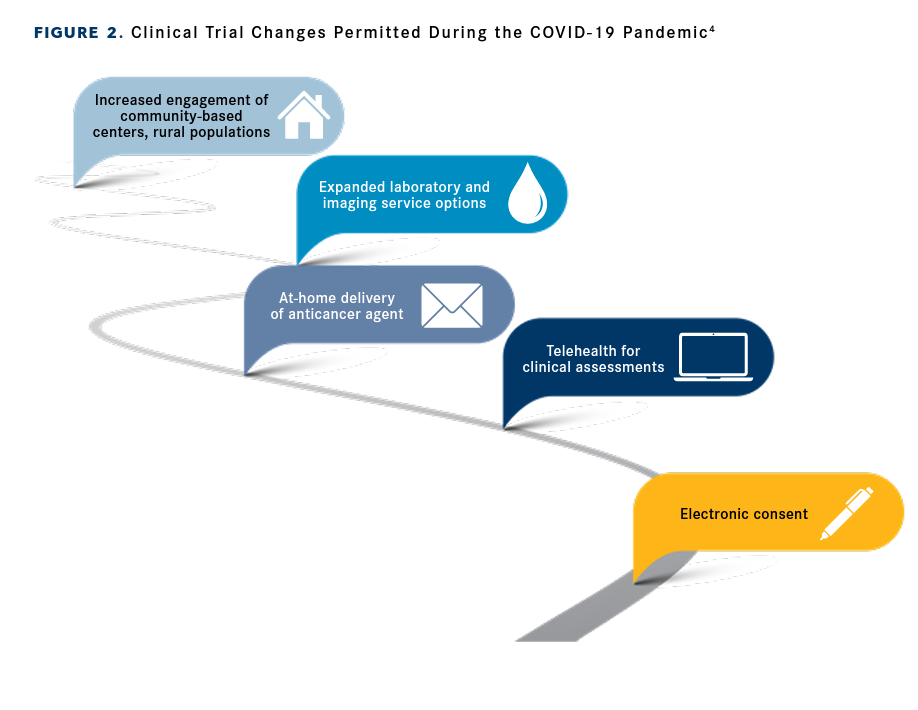
Virtual visits offer a good alternative choice for oncologists to continue care when a patient has a COVID-19 infection or only needs a routine status check, he said. At the same time, Penberthy himself has had a “mixed experience” with telemedicine and prefers meeting with patients in person. “If there’s a visit where [a provider] has to do a physical exam of a specific type, a head-neck physical exam, a gynecologic physical exam, those things can’t really be done via telemedicine,” he said.
Kenneth Adler, MD, chairman of the American Society of Hematology Practice Partnership, a hematologist-oncologist at the Summit Medical Group, assistant clinical professor of medicine at the New Jersey Medical School, and hospice medical director at the Visiting Nurse Association of Somerset Hills in New Jersey, described the back-to-back video visits he did early in the pandemic as “exhausting” and said his practice is doing fewer now. Telemedicine visits were also scaled back at the University of Pennsylvania’s Abramson Cancer Center in Philadelphia, according to Lawrence N. Shulman, MD, the center’s deputy director for clinical services and director of the Center for Global Cancer Medicine.
FIGURE 3. Effect of COVID-19 on Cancer Research
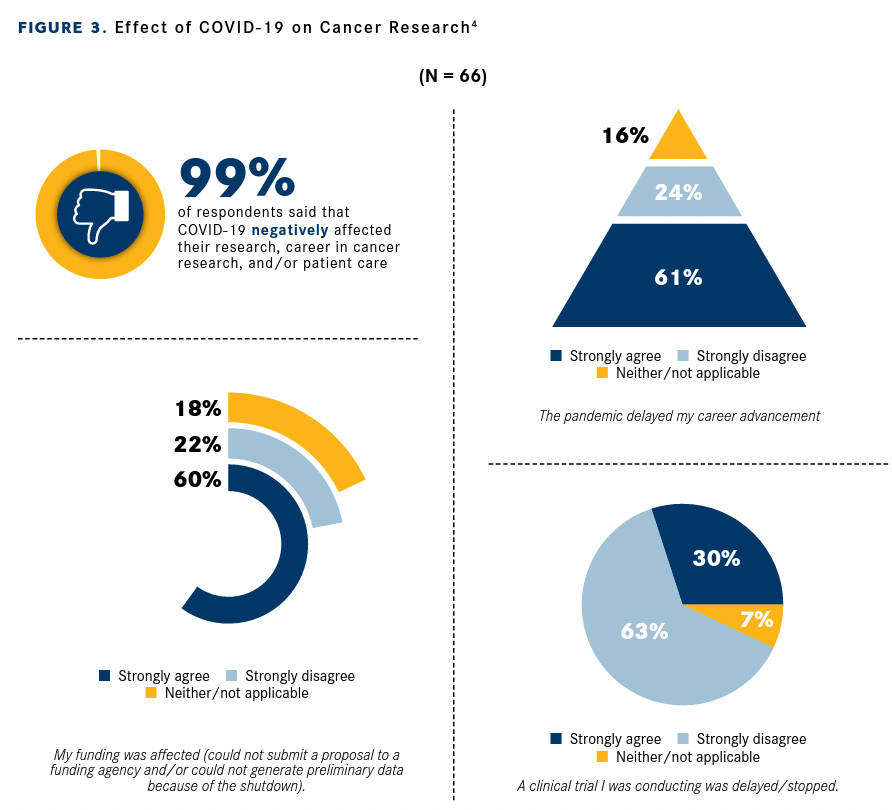
Penn Medicine clinicians would like to take greater advantage of telemedicine, but they have been held back by regulations restricting patients from being treated by doctors who are licensed in other states, he said. “Many of us in the profession would like to see federal legislation that made it possible for us to extend telemedicine across state borders more easily,” Shulman said.
Federal regulation will play a large role in future of telemedicine. The Department of Health and Human Services enabled the rapid switch to telemedicine in 2020, waiving certain restrictions, including those on reimbursement for Medicare and Medicaid patients by declaring a public health emergency. The agency has since issued several 90-day renewals of the emergency provisions. A coalition of health care technology organizations is calling for a longer extension and for eventual passage of permanent telehealth legislation by Congress.3
The necessary changes prompted by the pandemic reach all aspects of care including in the design and conduct of clinical trials. The American Association of Cancer Research published a report highlighting the most effective changes in care as a result of the pandemic.4 The rise of telemedicine helped to pave a path forward for the continuation of clinical studies along with the increased use of electronic consent and the shipment of experimental anticancer therapeutics to patients’ residences.
TABLE. Cancer Screening Affected by COVID-19
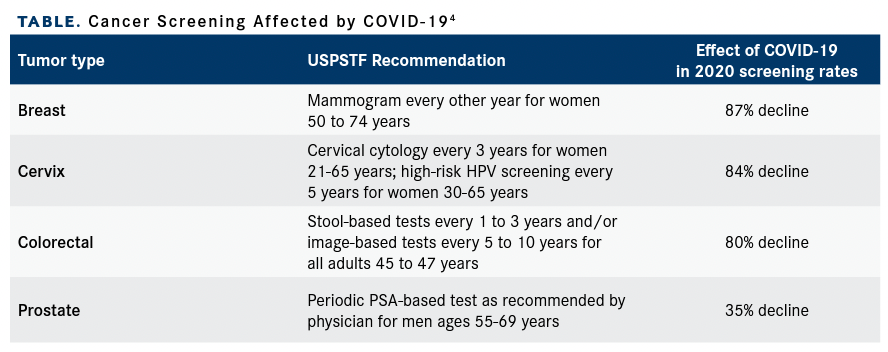
“The regulatory changes to the design of clinical trials offer a path forward for patient care that is patient-focused and have the potential to increase patient participation and minimize the time it takes to safely test anticancer therapeutics,” the authors of the report wrote. “These adaptations can also minimize the financial burdens (eg, cost of travel to the health care facility) and logistical burdens (eg, taking time off from work to go to a health care facility) on clinical trial participants.”
For more on the findings of the report see FIGURES 1-3 and the TABLE.
Screening Strategies
Modifications to standards of clinical care were on the road to widespread adoption, but some experienced a more rapid uptake as a result of the pandemic. Shorter schedules of hypofractionated radiation therapy for breast, prostate, and other cancers, which were already common in Canada and other countries but relatively rare in the United States, were added at many clinics beginning in 2020.
Penberthy said the move to hypofractionation has been accompanied by wider use of stereotactic radiation, a method that more precisely targets tumors with high doses of radiation, allowing fewer treatments and sparing nearby healthy tissue.5 It is used to treat spine, liver, brain, and other cancers. Instead of surgery, some patients with early-stage lung cancer can receive 5 stereotactic treatments, or sometimes as little as a single dose, he said.
New stereotactic radiation programs require state regulatory approvals, expensive new technology, and staff training, but even so they are becoming common both at large cancer centers and community practices such as Penberthy’s. “It’s filtering into the community relatively rapidly, but the community clinic has to show some institutional emphasis on doing things in such a way that they’re willing to invest in the program,” he said.
Penberthy said stereotactic radiation is among a number of innovations that will help address the consequences of missed screenings and interruptions in care caused by the pandemic. He noted results of a survey from the American Society for Radiation Oncology conducted in March 2021 showed that patients were presenting with more advanced disease at the time of diagnosis.6
“We’re very concerned about the long-term effects [of delays in screening]. Will the outcomes actually be worse as a result? We don’t have that data just yet. But there are new advances in health care delivery, with stereotactic radiation, with immunotherapy, and so we’re hopeful that the outcomes will be as good as they have been before the pandemic,” he said.
Mobile and at-home screening methods will also play a role in preventing a “third wave of suffering” during the pandemic as a result of chronic diseases that have not been diagnosed or treated, according to Paul J. Limburg, MD, a gastroenterologist at the Mayo Clinic in Rochester, Minnesota, and chief medical officer for screening at Exact Sciences, the parent company of the Cologuard and Oncotype DX tests.
Colorectal cancer (CRC) screening rates have been rising since 2014, largely because of the approval and use of Cologuard, a multitarget stool DNA test, according to research coauthored by Limburg.7 In a retrospective study of 8 years of insurance claims, Limburg et al found that uptake of the test increased from 2% in 2016 to 15% in 2018, and Limburg said he expects the figure has continued to rise since then.
“With constrained capacity for onsite procedures [including] colonoscopy, the interest in home-based screening options [such as] stool testing or Cologuard has really gained greater traction,” Limburg said. Tests delivered to patients’ homes provide “an opportunity to keep [individuals] where they are and potentially want to be, rather than having to go to a facility where they may not have the same experience, [or where] they may be more exposed to viruses or other people who have illnesses.”
In May 2021 the United States Preventive Services Task Force released a final recommendation statement, which concluded that CRC screening should begin 5 years earlier than previously recommended, at 45 years vs 50 years, and listed Cologuard as a recommended screening method for all average-risk adults age 45 to 75 years.8
Adaptation of Dosing Regimens
The exigencies of the COVID-19 pandemic led to several shifts in the ways well-known drugs are used to treat tumors. Many practices switched patients to oral agents, when possible, particularly capecitabine in place of infusion fluorouracil for patients with breast and gastrointestinal (GI) cancers. Other effective substitutes have included oral temozolomide (Temodar) for patients with brain cancers and certain oral targeted agents for advanced melanoma, Penberthy said.
A concern with oral drugs is adherence and the need for staff to check in frequently with patients. Shulman and his colleagues have been studying the use of automated chatbot software to monitor patients on a daily basis and make sure they have been taking their medicine on schedule.
Results of one small study from the University of Pennsylvania found that chatbots could successfully monitor treatment adherence of patients with GI neuroendocrine tumors (n = 10) who were prescribed capecitabine and temozolomide.9 Two ongoing chatbot studies have enrolled patients with GI cancers receiving capecitabine and patients with lung cancer receiving various oral targeted therapies including crizotinib and erlotinib, respectively, Shulman said.
Physicians at Penn Medicine and other centers have also begun administering less-frequent, higher-dose pembrolizumab (Keytruda) for patients with metastatic melanoma and several other cancers. The regimen—pembrolizumab 400 mg every 6 weeks—was approved by the FDA for all adult indications in April 2020.10
“[The updated dosing regimen] reduced patients’ need to come into the clinic by 50%,” Schulman said. “That was better for them, and it helped us to decant our clinics and our infusion rooms while still giving what we thought was equally adequate and effective therapy. I doubt that [approval] would have happened if COVID-19 hadn’t come along.”
Accelerated approval of this new dose was based on pharmacokinetic (PK), efficacy, and safety data from cohort B of the KEYNOTE-555 trial (NCT03665597), which used a model-based assessment to compare the new regimen with the standard dose of 200 mg every 3 weeks.11 Interim data for patients with metastatic melanoma who had received 1 cycle of pembrolizumab in the first line (n = 101) showed a clinically meaningful overall response rate (ORR) of 50.5% (95% CI), 20.4%-60.6%). Additionally, the median progression-free survival of 13.8 months (95% CI, 3.0-not reached) was cited as durable, with PFS rates of 56.5% at 6 months and 54.3% at 12 months. Investigators noted that these data were consistent with model-based predictions and were similar to the ORR in previous studies with pembrolizumab in the same patient population. Safety was also found to be similar.
Schulman noted that patients with melanoma and other diseases who are responding well to immunotherapy treatment can also skip one of their every-6-week immunotherapy doses. This comes to light as infusion centers face staffing shortages in the wake of COVID-19 variant surges. “We’re not necessarily saying we’re never going to give them the drug again, but we feel reasonably comfortable with omitting a dose at a time when we’re really stretched,” Schulman said. “In a case-by-case, and disease-by-disease, and treatment-by-treatment manner, all of us are looking at which patients we think can skip a dose or be delayed, so patients who really need to be treated, we have the capacity to treat.”
Some patients with melanoma experience prolonged remissions that last for years, and the pandemic experience has underlined the need for data on when immunotherapy can be safely paused or discontinued, Shulman said. Results of studies evaluating drug holidays have had mixed conclusions, although he noted that some research on patients with advanced colorectal cancer and other tumors showed that pausing treatment did not affect overall survival (OS). “I think we’re going to be more anxious to try to address those issues and come up with scientific data that helps to guide us,” he said.
Schulman pointed to a recent pooled analysis of 6 phase 3 trials evaluating adjuvant chemotherapy for patients with stage 3 colon cancer. Investigators compared disease-free survival after a 3-month course of treatment vs a 6-month course.12 Noninferiority of the 3-month regimen was not confirmed, but investigators found an absolute difference of 0.4% in 5-year OS rates and said the results support the use of 3 months of adjuvant CAPOX (capecitabine and oxaliplatin) for most patients. Results also showed a substantial reduction of toxicities, inconvenience and cost associated with a shorter treatment duration.
Neoadjuvant Therapies
Another significant change is toward increasing the use of neoadjuvant therapies to delay or avoid surgery. Adler said he has been prescribing hormone treatment alone for some of his older patients with breast cancer and has observed good responses to therapy. Meanwhile, he has tried a similar tactic with younger patients with breast cancer, administering 3 to 4 months of chemotherapy to delay surgery or shrink their tumors so they may undergo a less intensive procedure, such as a lumpectomy.
“[Neoadjuvant therapy] was done before [the pandemic] for patients, it’s an accepted approach,” Adler said. “[However,] there’s no question that in the past 2 years it’s been done more because of COVID-19 [and] there’s a good possibility it will be done more.”
Data from recent studies support Adler’s observations for the expanded use of neoadjuvant therapies in select groups of breast cancer patients. A retrospective study of 366 patients with early-stage breast cancer treated at Penn Medicine compared the treatment of those who received a diagnosis of cancer between January 1 and May 15, 2018, with those who received a diagnosis between January 1 and May 15, 2020.13 Investigators reported an increased use of preoperative systemic therapy in 2020 (43.9% overall; 20.7% chemotherapy; and 23.2% hormonal therapy) vs 2018 (16.4% overall; 12.4% chemotherapy; and 4.0% hormonal therapy) (P < .001). Notable, an 18.8% decrease in patient volume was reported in 2020 vs 2018.
Further, data from a pooled analysis published in the British Journal of Cancer of 2 phase 2 trials evaluating neoadjuvant anastrozole and fulvestrant efficacy for postmenopausal hormone receptor–positive, HER2-negative patients with breast cancer—HORGEN (NCT00871858) and CARMINA02 (NCT00629616)—showed that patients receiving neoadjuvant endocrine therapies (NET) generally have improved surgical outcomes and that treatment is better tolerated than chemotherapy.14
Among 217 evaluable patients in the intentionto-treat analysis, the relapse-free survival (RFS) rate at 5 years was 83.7% (95% CI, 77.9%-88.0%). The 5-year OS rate was 92.7% (95% CI: 88.2%95.6%), with no difference observed between patients who received anastrozole or fulvestrant.
Alternative neoadjuvant strategies have proven effective for other subgroups of patients with breast cancer. For example, survival outcomes for 640 patients with strongly hormone receptor–positive, HER2-negative breast cancer in a Taiwanese registry database showed that neoadjuvant chemotherapy (NACT) resulted in better outcomes over NET.15 Patients treated with NET had a higher risk of all-cause death with an adjusted HR of 2.67 (95% CI, 1.95-3.51).
Despite the evidence across various studies for treatment adjustments and delays, decisions should be determined by what will provide the best outcomes for the individual patient.
References
- Cruz Da Silva E, Mercier MC, Etienne-Selloum N, Dontenwill M, Choulier L. A systematic review of glioblastoma-targeted therapies in phases II, III, IV clinical trials. Cancers (Basel). 2021;13(8):1795. doi:10.3390/cancers13081795
- Wen PY, Stein A, van den Bent M, et al. Dabrafenib plus trametinib in patients with BRAF V600E-mutant low-grade and high-grade glioma (ROAR): a multicentre, open-label, single-arm, phase 2, basket trial. Lancet Oncol. 2022;23(1):53-64. doi:10.1016/S1470-2045(21)00578-7
- Targeted drug combination shows unprecedented activity in some highly aggressive brain tumors. News release. Dana-Farber Cancer Institute. November 24, 2021. Accessed February 24, 2022. https://bit.ly/3BPH0f4
- Thakkar JP, Peruzzi PP, Prabhu VC, eds. Glioblastoma multiforme. American Association of Neurological Surgeons. Accessed February 28, 2022. https://bit.ly/36TuQ9L
- Ostrom QT, Gittleman H, Fulop J, et al. CBTRUS statistical report: primary brain and central nervous system tumors diagnosed in the United States in 2008-2012. Neuro Oncol. 2015;17(suppl 4):iv1-iv62. doi:10.1093/neuonc/nov189
- Louis DN, Perry A, Wesseling P, et al. The 2021 WHO Classification of Tumors of the Central Nervous System: a summary. Neuro Oncol. 2021;23(8):1231-1251. doi:10.1093/neuonc/noab106
- NCCN. Clinical Practice Guidelines in Oncology. Central nervous system cancers, version 2.2021. Accessed February 26, 2022. https://www.nccn.org/professionals/physician_gls/pdf/cns.pdf
- Avastin. Prescribing information. Genentech; 2020. Accessed March 1, 2022. https://bit.ly/3hzoMoI
- Glas M, Kebir S. Regorafenib in glioblastoma recurrence: how to deal with conflicting ‘real-life’ experiences? Ther Adv Med Oncol. 2019;11:1758835919887667. doi:10.1177/1758835919887667
- Subbiah V, Baik C, Kirkwood JM. Clinical development of BRAF plus MEK inhibitor combinations. Trends Cancer. 2020;6(9):797-810. doi:10.1016/j.trecan.2020.05.009
- Yan H, Parsons DW, Jin G, et al. IDH1 and IDH2 mutations in gliomas. N Engl J Med. 2009;360(8):765-73. doi:10.1056/NEJMoa0808710
- Tibsovo. Prescribing information. Servier Pharmaceuticals; 2021. Accessed March 1, 2022. https://bit.ly/3syjhgp
- Idhifa. Prescribing information. Celgene Corporation; 2020. Accessed March 1, 2020. https://bit.ly/3tlZ8JJ
- Konteatis Z, Artin E, Nicolay B, et al. Vorasidenib (AG-881): a first-in-class, brain-penetrant dual inhibitor of mutant IDH1 and 2 for treatment of glioma. ACS Med Chem Lett. 2020;11(2):101-107. doi:10.1021/acsmedchemlett.9b00509
- Mellinghoff IK, Penas-Prado M, Peters KB, et al. Vorasidenib, a dual inhibitor of mutant IDH1/2, in recurrent or progressive glioma; results of a first-in-human phase I trial. Clin Cancer Res. 2021;27(16):4491-4499. doi:10.1158/1078-0432.CCR-21-0611
